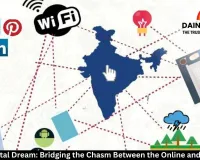Energy Independence: India-Nepal Power Pacts Ignite South Asia’s Green Ambitions
Digital Desk

In a significant move for regional energy security, India and Nepal have inked agreements to construct two new high-capacity transmission lines, a development that promises to bolster cross-border electricity trade and help unlock Nepal's vast hydropower potential.
This collaboration arrives as India, having recently surpassed a monumental 500 GW of total installed power capacity, accelerates its own journey toward renewable energy dominance .
India's Renewable Energy Ascent
India's power sector is undergoing a historic transformation, establishing a strong foundation for its energy independence goals. The country has not only crossed the 500 GW total capacity mark but has also achieved one of its key COP26 Panchamrit goals five years ahead of schedule: over 51% of its installed capacity now comes from non-fossil fuel sources .
This remarkable progress is led by the rapid growth of solar and wind energy. As of late 2025, solar power leads with an installed capacity of 127.33 GW, followed by wind power at 53.12 GW .
The government's strategic focus is now expanding to include emerging technologies like battery energy storage systems and green hydrogen, with its National Green Hydrogen Mission aiming to develop 5 million metric tonnes of production capacity per annum by 2030 .
Unlocking Nepal's Hydropower for Regional Cooperation
While India scales its renewables, Nepal holds a key to regional energy stability: an estimated 11,000 megawatts of hydropower capacity is currently in the pipeline .
However, this potential remains locked without adequate infrastructure to export the electricity and stabilize the grids of energy-hungry neighbors.
The newly signed agreements directly address this bottleneck. The two 400 kV cross-border transmission lines Inaruwa (Nepal)-New Purnea (India) and Lamki (Nepal)-Bareilly (India) will create vital arteries for power exchange .
The partnership model is itself a testament to deepening cooperation; for the section in Nepal, the Nepal Electricity Authority (NEA) will hold a 51% stake and Power Grid Corporation of India Limited (PGCIL) 49%, with the ownership structure reversed for the Indian section .
This 80% debt and 20% equity financed projects are targeted for completion by 2030 .
A Strategic Path to Energy Independence
For India, partnerships with Nepal and other South Asian nations are a strategic imperative. They are essential for managing its own grid stability amid the variable nature of solar and wind power and meeting soaring energy demand. Integrating Nepal's hydropower can provide a stable, clean base load, much like a giant battery for the region.
This vision of an interconnected grid is slowly becoming a reality. These new lines will join the already operational 400 kV Dhalkebar–Muzaffarpur line and the under-construction Butwal–Gorakhpur line, creating a resilient network that moves beyond bilateral trade toward a regional energy market .
As Nepal's Energy Minister Kulman Ghising stated, this infrastructure will allow Nepal to "access international energy markets, boosting domestic and foreign investment in the hydropower sector" .
The journey toward full energy independence is complex, but the latest agreements between India and Nepal mark a decisive step forward.
By leveraging India's renewable energy ambitions and Nepal's hydropower potential through concrete infrastructure projects, South Asia is building a more sustainable, interconnected, and self-reliant energy future.





.jpg)

.jpg)

.jpg)
